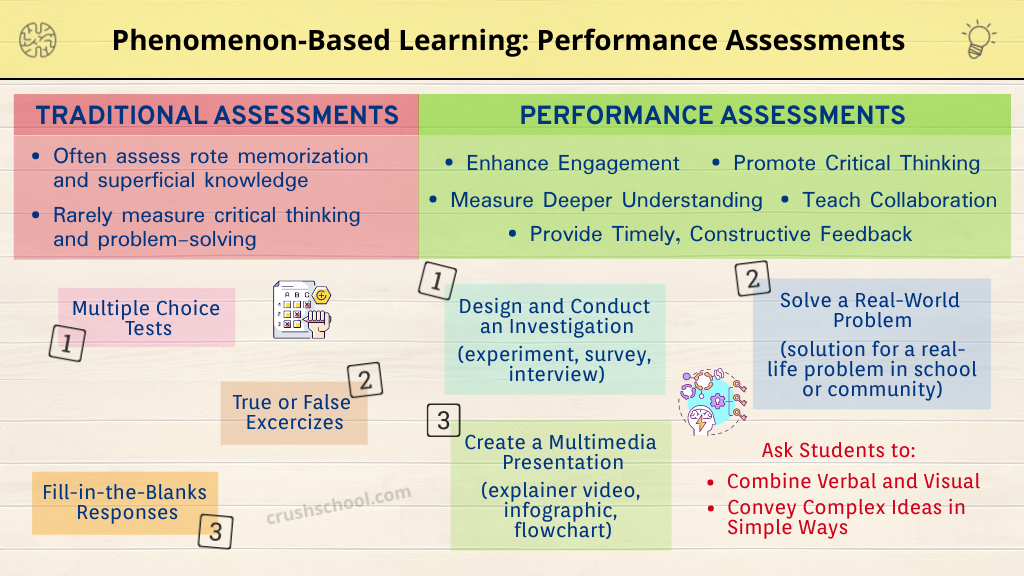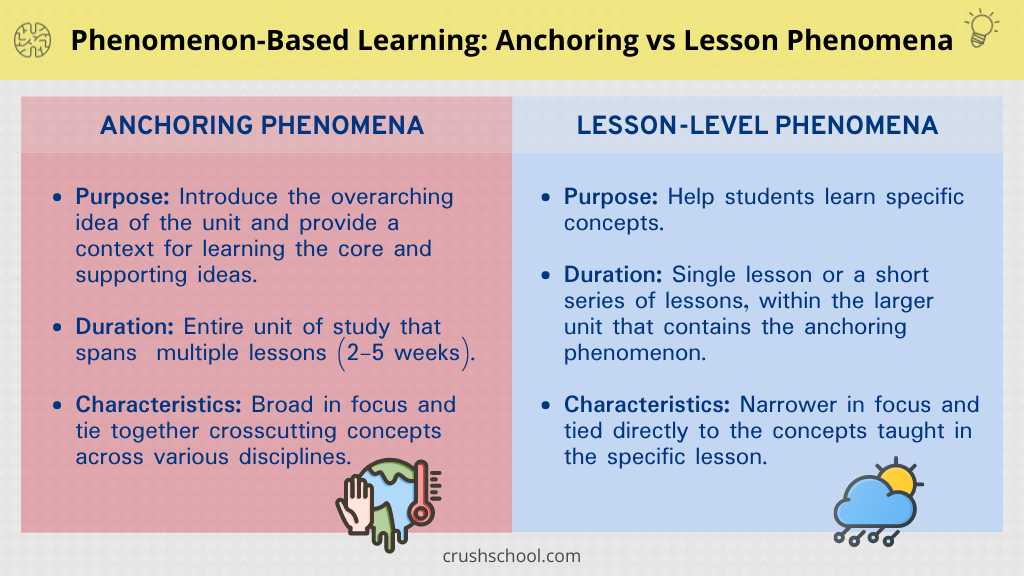Creating Performance Assessments for Phenomenon-Based Learning
As concerns grow that traditional assessments such as tests frequently fall short of capturing the depth of students' understanding and fail in measuring their ability to apply knowledge in real-world scenarios, Phenomenon-Based Learning (PhenBL) has emerged as a student-centered approach that prioritizes building comprehension through active inquiry. To align with this innovative instructional method, educators are turning to performance assessments – powerful tools that have the potential to unleash creativity, transformative skill-building, and deeper learning.
Understanding Phenomenon-Based Learning
Phenomenon-Based Learning is an inquiry-driven approach that uses real-world phenomena to engage students in exploration. Rather than starting by explaining facts and concepts to students, PhenBL is predicated on the learners investigating phenomena and forming understandings of the underlying principles (facts and concepts) behind these phenomena.
The Limitations of Traditional Assessments
Traditional assessments, such as multiple-choice exams, often assess rote memorization and superficial knowledge. They rarely measure skills such as critical thinking and problem-solving or in-depth knowledge. These assessments also fail to show students' ability to apply knowledge to real-life situations, which is a central goal of PhenBL and should be the goal of all learning.
Benefits of Performance Assessments
Performance assessments offer a transformative alternative to traditional testing methods. They focus on students' ability to apply knowledge, skills, and strategies to authentic, real-world scenarios. By leveraging performance assessments in phenomenon-based learning, we can:
Measure Deeper Understanding: Performance assessments allow educators to observe how well students comprehend and apply scientific concepts in practical contexts. For instance, students could conduct experiments, analyze data, and draw meaningful conclusions based on their observations.
Promote Critical Thinking: Performance assessments encourage students to think critically and creatively as they tackle complex problems related to the phenomenon. This enhances their ability to make connections, analyze information, and devise innovative solutions.
Teach Collaboration: Many performance assessments involve group projects or problem-solving, which cultivates effective teamwork and communication skills. Collaboration also enables students to share their unique perspectives and learn from each other.
Provide Timely, Constructive Feedback: Many meaningful performance assessments take more than one day to complete allowing opportunities for formative assessment. As teachers check in with various teams, they can provide timely feedback that guides students' progress. Such personalization enables teachers to assess understanding, keeps students on track, drives continuous improvement, and supports students' growth.
Enhance Engagement: Performance assessments take advantage of student interests and provide real-life relevance. Engaging in hands-on investigation and creation builds intrinsic motivation and enthusiasm for learning of content as the PhenBL vehicle connects the world of school with the world outside of it.
Examples of Performance Assessments in Phenomenon-Based Learning
Design and Conduct an Investigation: Students can be tasked with designing and conducting their own investigations related to the phenomenon in question. They can develop hypotheses, plan experiments, gather data, and draw conclusions, showcasing their inquiry and experimental skills and gaining deeper knowledge of the concepts. For example, you could challenge students to design a school-wide survey on a social or psychological topic or to use the web as a resource to design an experiment that demonstrates and helps them explain (and thus learn) a science concept.
Create a Multimedia Presentation: Students can create multimedia presentations such as explainer videos that contain models of phenomena concepts, or infographics that explain and exemplify a phenomenon to a broader audience. The key for teachers is to combine visual and verbal communication skills and challenge students not to read the information they wrote down, but rather convey the complex ideas in a simple way that is effective in both showing what the students learned and teaching the audience about the concepts and mechanisms responsible for the phenomenon studied. Check out my Coral Bleaching Project to get an idea for how to set this up.
Solve Real-Life Problems: Challenge students to apply their understanding of the phenomenon to solve real-world problems. For example, they might devise sustainable solutions for an environmental issue around you school, such as lack of composting or recycling. Or they might propose an engineering design solution for some observed inefficiency. The idea is not to have students change the world in situ, though that’s highly desirable if possible, but to have them practice critical thinking, problem-solving, and design skills in an authentic way while learning content at the same time. For example, they could research and design a safer, or more interesting playground for the elementary school nearby. Their dream playground might not get built but their skills will be.
Learning and Growing through Performance Assessments
Performance assessments can provide a dynamic and effective means of evaluating students' learning in Phenomenon-Based Learning. By focusing on application, critical thinking, and collaboration, these assessments align perfectly with the goals of PhenBL. Embracing performance assessments empowers students to demonstrate the depth of their understanding and equips them with the skills they need to succeed in an ever-changing world. As educators continue to explore the potential of Phenomenon-Based Learning, performance assessments stand out as a valuable ally in nurturing a new generation of engaged, inquisitive, and capable professionals.
If you found this post helpful, sign up for my Teaching Tips, Resources, & Ideas Newsletter to get the next article when it drops. It’s totally free.
BOOKS & TOOLS
- September 2025 2
- August 2025 5
- July 2025 4
- June 2025 2
- August 2024 2
- July 2024 2
- June 2024 1
- October 2023 1
- September 2023 3
- August 2023 6
- July 2023 6
- July 2022 2
- June 2022 1
- November 2020 3
- October 2020 3
- April 2020 1
- March 2020 5
- July 2019 1
- June 2019 1
- April 2019 1
- January 2019 1
- November 2018 3
- October 2018 2
- September 2018 1
- August 2018 8
- July 2018 11
- June 2018 4
- May 2018 5
- April 2018 2
- March 2018 4
- February 2018 5
- January 2018 3
- December 2017 1
- November 2017 5
- October 2017 7
- September 2017 6
- August 2017 5
- July 2017 3
- June 2017 10
- May 2017 7
- April 2017 7
- March 2017 15
- February 2017 12
- January 2017 13
- December 2016 15
- November 2016 8
- October 2016 7
- September 2016 12
- August 2016 14
- July 2016 10
- June 2016 13
- May 2016 10
- April 2016 8
- March 2016 5
- February 2016 7
- January 2016 6
- December 2015 5
- November 2015 8
- October 2015 2















